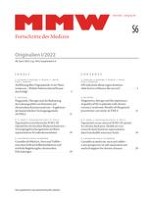Erschienen in:

22.04.2022 | Opioide | FB_Übersicht
Tapentadol versus klassische WHO-III-Opioide bei chronischen Rückenschmerzen
Versorgungsforschungsstudie auf Basis repräsentativer Krankenkassendaten
verfasst von:
PD Dr. med. habil. Kai-Uwe Kern, Dipl.-Volksw. Tobias Vogelmann, Prof. Dr. med. Dr. rer. nat. Thomas R. Tölle
Erschienen in:
MMW - Fortschritte der Medizin
|
Sonderheft 6/2022
Einloggen, um Zugang zu erhalten
Zusammenfassung
Hintergrund/Zielsetzung: In klinischen Studien zeigte Tapentadol retard in der Schmerzbehandlung im Vergleich zu anderen starken Opioiden ein besseres gastrointestinales Verträglichkeitsprofil. In der vorliegenden Analyse wurden Tapentadol retard und klassische retardierte WHO-III-Opioide in der Versorgungsrealität verglichen.
Methode: Retrospektive Kohortenstudie (Matched-Pair-Ansatz) anonymisierter Krankenkassendaten von Patienten mit chronischen Rückenschmerzen, denen nach Vortherapie mit WHO-I/II-Analgetika starke Opioide verordnet wurden. Die Datenauswertung erfolgte ausgehend vom Datum der Indexverordnung im Jahr 2015 über einen Nachbetrachtungszeitraum von maximal zwei Jahren. Der primäre Analyseparameter war die Verordnung von Laxanzien.
Ergebnisse: In die Analyse konnten die Daten von 227 Patienten pro Kohorte einbezogen werden. Unter Tapentadol retard wurde im Vergleich zu WHO-III-Opioiden signifikant weniger Patienten Laxanzien verordnet (20,3% vs. 37%; p < 0,0001). Die Dosierung der Laxanzien war signifikant geringer in der Tapentadol-Kohorte (26,4 vs. 82,5 durchschnittliche definierte Tagesdosen; p < 0,0001). Auch unter Langzeitbehandlung wurde ein signifikanter Unterschied in der Laxanzienverordnung beobachtet (27,7% Tapentadol-retard-Patienten vs. 50% Patienten mit WHO-III-Opioiden; p = 0,0029).
Schlussfolgerung: Die bessere gastrointestinale Verträglichkeit von Tapentadol retard in der Behandlung chronischer Schmerzen, die bereits in klinischen Studien und Anwendungsbeobachtungen gezeigt wurde, konnte indirekt in der Versorgungsrealität bestätigt werden.
Schlüsselwörter: Chronischer Rückenschmerz, gastrointestinale Verträglichkeit, Tapentadol, Versorgungsforschung, WHO-III-Opioide
Eingereicht am 19.11.2021 - Revision akzeptiert am 25.1.2022












